The planetary science group has expertise in building and operating different types of instruments
Plasma analysers
Stereo camera systems
Micro Penetrator
Cassini Plasma Spectrometer
Fonema
Johnstone Plasma Analyser
Plasma analysers
Plasma analysers are used to detect charged particles (ions and electrons) in space.
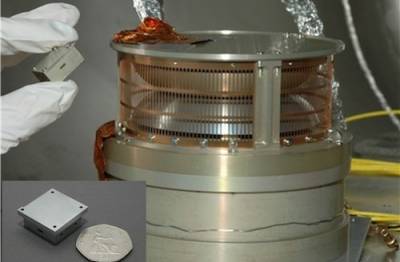
Stereo camera systems
MSSL has built stereo cameras for Beagle 2 and is developing a camera called PanCam for ESA's ExoMars rover.
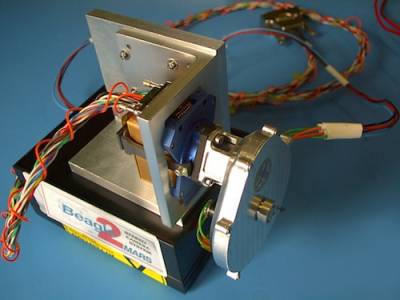
The images below show some example images from the Beagle 2 stereo camera system.
Science goals
- The scientific objectives for such cameras include:
- Building digitial elevation models to calculate safe paths for robot arm movements.
- Generating colour and greyscale stereo panoramas.
- Studying geology and mineralogy.
- Measuring dust opacity and water vapour in the atmosphere of Mars.
Micro penetrators
Kinetic micro-penetrators are tiny probes which impact planetary bodies at high speed and bury themselves into the planetary surface.
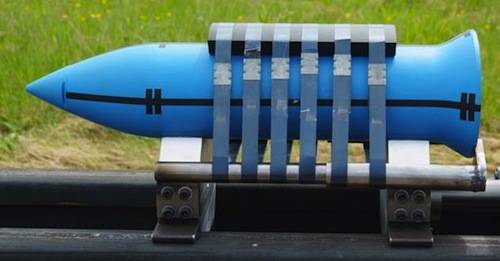
Because they are small this allows many probes to be deployed at wide spacings across the planetary surface. They also naturally provide redundancy so no mission is vulnerable to the loss of a single probe.
Key scientific investigations
Whilst their small size does not allow a full complement of the most capable scientific instruments, they are ideal to perform focused investigations across widely space surfaces of the body not currently feasible with soft landers and rovers. For example:
- For the jovian satellite Europa, seismometers could determine the presence of an under-ice ocean, and the possible existence of an habit for extraterrestrial life, and organic chemical detection of the associated chemistry.
- For the Moon, a seismic network could provide information into the origin of the Earth-Moon system, and ground truth as to whether water and other volatiles exists in permanently shaded areas in polar craters.
- For NEOs (Near Earth Objects) this could confirm whether they are rubble piles consisting of rather loose agglomerates of rock and dust, or hard rocky bodies as originally thought.
Consortium
MSSL are leading the consortium that are developing micro-penetrators and also develop payload technologies and system designs. Other consortium members include:
- Consortium
- Birkbeck College London - Science Imperial College London - Micro-seismometers
- Oxford University - (Atmospheric, Oceanic & Planetary Physics) Micro-seismometers
- Open University - Science and instrumentation
- QinetiQ - Impact, power and communications technologies
- Southampton University - Optical Fibres
- Surrey Space Science Centre - Sample acquisition, thermal probes and heat switch
- SSTL - Platform and delivery system technologies
- University of Leicester - Geochemical sensors and planetary protection
- Astrium - Descent Module and thermal analysis
- Lancaster University - Planetary Science
- MagnaParva - Sample Handling
and international partners:
- JIVE, Netherlands - Radio Beacon ROB, Belgium - Radio Beacon IFSI, Rome, Italy - Micro-micro thermogravimeter IWF, Graz, Austria - Permittivity INTA, Madrid, Spain - Astrobiology ICTP, Trieste, Italy - Astrobiology
Cassini Plasma Spectrometer (CAPS)
The Cassini Plasma Spectrometer (CAPS) team is led by Principal Investigator Frank Crary at Southwest Research Institute with contributions from an international team of co-investigators. The CAPS instrument consists of three sensors: an ion mass spectrometer provided by the Los Alamos National Laboratory (LANL) and CRPE (France), an ion beam spectrometer produced by LANL and VTT (Finland) and an electron spectrometer (ELS) provided by a European team led by MSSL (lead co-investigator Andrew Coates, project manager Gethyn Lewis). The ELS team includes the Rutherford Appleton Laboratory (RAL) and the Norwegian Defence Research Establishment (NDRE), who fulfill similar roles to those that they have in the Cluster PEACE team. An image of the CAPS instrument is on the right-hand side.
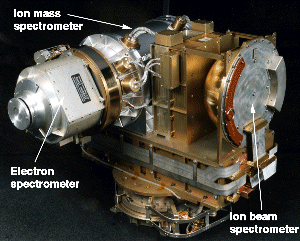
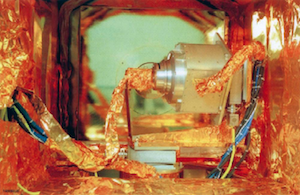
Scientific results from CAPS/ELS include:
- Discovery of an ionosphere over Saturn's rings.
- Discovery of large negatively charged molecules in Titan's upper atmosphere.
- Discovery of charged ice grains in plumes of gas escaping from Enceladus' south pole.
Fonema
The FONEMA (Fast Omni-directional Non-scanning Energy Mass Analyser) was a package of instruments included on the Mars 96 orbiter payload to study the solar wind interaction with Mars. MSSL was the PI institute for FONEMA in collaboration with MFFUK (Czech Republic), who supplied the high voltage units and the EGSE, CESR (France) and STIL (Ireland), who provided the DPU, IKI (Russia) and OKB (Kirghizia).
FONEMA would have studied the structure, dynamics and origin of the plasma population of near-Mars space by measurements of three dimensional distribution functions of hot ions with a high time resolution in the energy range from 20 eV to 8 keV. The instrument consists of 36 Thomson parabola energy mass analysers which make measurements within their own solid angle determined by a pair of hyperbolic electrostatic mirrors and a focussing particle collimator system. Within each analyser parallel electrostatic and magnetic fields deflect the incoming ions to produce parabolic images on an MCP/Wedge Strip anode imaging system. Encoding electronics then produce energy spectra for 4 different mass groups from which the onboard software within the Data Processing Unit (DPU) will produce full distributions
Johnstone Plasma Analyser
The Johnstone Plasma Analyser (JPA) aboard the Giotto spacecraft consisted of an Implanted Ion Sensor (IIS), Fast Ion Sensor (FIS) and Common Digital Processing Unit (DPU). They were designed to cover the solar wind and cometary ions during the Halley encounter. The FIS was damaged during that encounter, and was thus not operating when the spacecraft flew by Grigg-Skjellerup. The instrument development was headed by the Space Plasma Physics Group of the Mullard Space Science Laboratory. Collaborators on the project were from The Max-Planck-Institut fuer Aeronomie (Germany), Istituto di Fisica dello Spazio Interplanetario (Italy), Kiruna Geophysical Institute (Sweden), Southwest Research Intitute (USA) and the Rutherford-Appleton Laboratory (UK).
The Fast Ion Sensor provided 3D positive ion distribution every 4 seconds in the energy range 10eV to 20 keV. This instrument was damaged during the Halley flyby, and was not operational during the Grigg-Skjellerup encounter.
The Implanted Ion Sensor covered cometary pickup ions in 32 energy levels from 86 eV to 86 keV, with a time resolution of 128 seconds (at Grigg-Skjellerup this provided a 1790km along-track resolution). The instrument had a very high sensitivity, to detect the low fluxes of cometary ions.
As its name suggests, the IIS is an ion spectrometer whose primary function was to investigate cometary ions implanted in the solar wind flow. Five sensors in the IIS covered the angular range of 15degrees to 165degrees in five equally-spaced 10degree sectors in a plane including the spacecraft spin axis. As the spacecraft rotated, three-dimensional coverage was provided of the ion populations. Each of the five sensors consisted of a spherical-section electrostatic segment analyser (ESA), and a time-of-flight (TOF) analyser.
The mean radius of the ESA sectors is 50mm, their plate spacing is 3mm, and the energy bandwidth deltaE/E = 10%. The outer plate was held at 0V, and up to -11kV could be applied to the inner plate. Positive ions were selected in the ESA according to their E/q. Following selection, the ions were accelerated by 10kV to pass through a thin carbon foil at the entrance of the TOF analyser. While passing through the foil, a small amount of energy was tranferred to secondary electrons that were deflected from the foil onto an MCP to record the `start' signal. The `stop' detector was an aluminium absorber which released secondary electrons from its surface layer. The error in flight-path length caused by coulomb angular scattering of the ions with atoms in the `start' foil was limited to ~5% by using a spherical concave shape for the `stop' detector.
The response of the incident ions to a given accelerating potential depends on q/mass and therefore the selected E/q and the measured time of flight (after acceleration) over a known path length are combined to give m/q. Counts are sorted into 5 mass bins using an on-board look-up table. Further pulses cannot be processed during the 25 microseconds required to process the signals for each event. The maximum time interval allowed between start and stop signals in 80ns (after which the event is discounted). Using this coincidence technique, a high rejection of background signals was given, allowing the relibale measurement of low densities.
During each spacecraft spin, an entire angular distribution was obtained by the instrument in one of the 32 logarithmically-spaced energy levels, from 86 eV/q to 86 keV/q. As the spacecraft rotated every 8 seconds, the entire energy range was covered by the IIS in 128 seconds.
For more detailed descriptions, see :
- A.D. Johnstone, J.A. Bowles, A.J. Coates, A.J. Coker, S.J. Kellock, J. Raymont, B. Wilken, W. Studemann, W. Weiss, R. Cerulli Irelli, V. Formisano, E. de Giorgi, P. Perani, M. de Bernardi, H. Borg, S. Olsen, J.D. Winningham and D.A. Bryant, ESA SP-1077, 15-32, 1985.
- A.D. Johnstone, A.J. Coates, B. Wilken, W. Studemann, W. Weiss, R. Cerulli Irelli, V. Formisano, H. Borg, S. Olsen, J.D. Winningham, D.A. Bryant and S.J. Kellock, The Giotto three-dimensional positive ion analyser, J. Phys. E: Sci. Instrum., 20, 795-805, 1987.
 Close
Close

